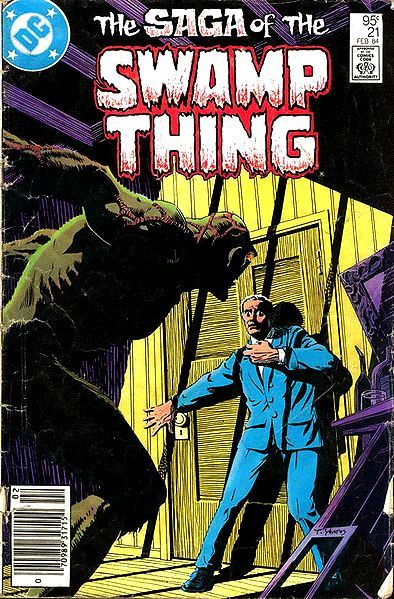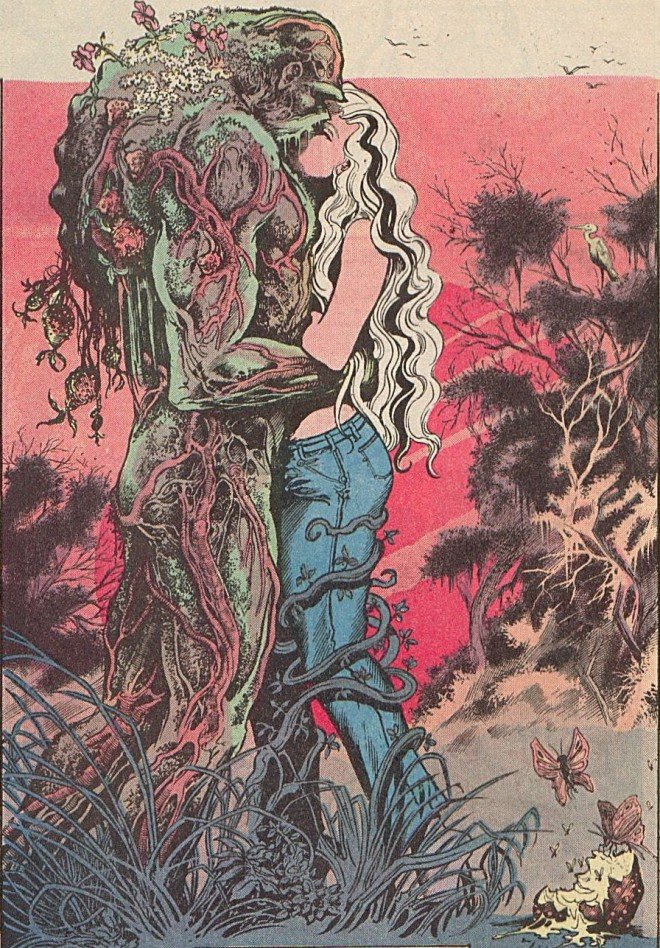About Alan Moore and his Swamp Thing – From Panel to Projection Booth |5|
In part 5 of Eoin Rogers’ series on the history of comic books, he looks at the role Alan Moore’s Swamp Thing played on the world of comics and how it formed the basis for adult comic book stories. Check out the previous articles here, here, here and here.
The Online Oxford Dictionary defines Godwin’s Law as;
“The theory that as an online discussion progresses, it becomes inevitable that someone or something will eventually be compared to Adolf Hitler or the Nazis, regardless of the original topic”
Building upon Godwin’s work I would like to take this opportunity to posit my own thesis, which I have drawn from my own observations concerning the world of comic books and superheroes. My hypothesis is thus;
Rogers’ Law; the theory that as a discussion about comic books progresses, it becomes inevitable that someone or something will eventually bring up the work of Alan Moore, regardless of the original topic.
Ladies and gentlemen we have now reached such a point. Alan Moore has officially entered the conversation.

Moore came onto the British comic book scene in the late 1970s writing for the acclaimed science fiction anthology 2000AD, home of Judge Dredd. He also wrote for the comic book magazine Warrior and in the early 80s began writing for MarvelUK. In 1982 the very first publication of Warrior featured a strip written by Moore entitled V for Vendetta. This strip, set in a dystopian future Britain ruled by a totalitarian dictatorship, saw Moore quite overtly tackling the political themes of the day; specifically Thatcher. These political overtones are telling of the shifting sensibilities of the comic book reading populace at large, who were now ready to read comic books and strips that weren’t centered on superheroes and that featured politically and dramatically mature content.
In 1983 Len Wein, the editor at DC and one of the original creators of Swamp Thing, brought Moore over to good old fashioned, American, mainstream comic books. He gave Moore The Saga of Swamp Thing title, seen as it had been slowing declining in sales and wasn’t doing particularly well. If Moore turned out to be a shyster there’d be no harm done seeing as The Saga of Swamp Thing was already headed down the swany. Moore took over the writing responsibilities with issue #20, published in January of 1984. In a story entitled ‘Loose Ends’ Moore, with neither pomp nor ceremony, brings the stray narrative odds and ends left unresolved by the previous writer Martin Pasko to a point of closure and kills the title character, Swamp Thing. A somewhat unconventional opening.

With issue #21, however, Moore goes about completely recasting the character of Swamp Thing. Bringing the character back to his roots, heh, Moore reinvigorates the The Saga of Swamp Thing title with the same drive and intention which spurned the Swamp Thing character into creation thirteen years earlier in 1971. Swamp Thing, formerly Alec Holland, was a scientist who through an unfortunate accident had been turned into a living man-plant. Moore rewrote this in “The Anatomy Lesson” issue #21 where the reader learns that Swamp Thing’s body is made up of a vegetative imitation of human organs which don’t work. Lungs made out of moss, a heart made out of lichen. It eventually transpires Swamp Thing isn’t, nor has it ever been, human. The accident which apparently transformed Alec Holland into Swamp Thing actually killed Holland and in the commotion the latent Swamp Thing latched onto his dying consciousness and convinced itself it was Alec Holland. It transpires that Swamp Thing is not dead at all, that Swamp Thing only thought it was dead, and so it rises up and continues to be the protagonist of Moore’s run. While this condensed summary of the first arc of Moore’s run on The Saga of Swamp Thing might make the story sound somewhat contrived, Moore handles the newly non-human character of Swamp Thing with compelling grace. Throughout the first issues of his run Moore develops Swamp Thing’s trauma and confusion as to who, or more accurately what, it is. It’s almost like Swamp Thing suffers from amnesia or post-traumatic stress as it comes to terms with the fact that it is not the person it thought it was and in fact, is not a person at all but a living plant consciousness.

Originally appearing in a one off story in House of Secrets #92, published 1971, Swamp Thing was a man-turned-monster, who killed his friend to protect his wife and then, rejected by her, he returns to the swamp. One shot stories of this nature were standard fair in House of Secrets and also in House of Mystery, its sister title, which were genre titles telling tales of horror and suspense. Moore took his cue from these origins and utilized contemporary genre tropes, as well as his extensive research, to give the book a literary bent, with some characters even seen reading Clive Barker’s Books of Blood. Story arcs on Moore’s run feature grimy underwater vampires living in the ruins of a flooded town, the ghosts of former slaves returning to haunt the houses of plantation owners in the Louisiana bayou, menstruating werewolves, and the return of the Anti-Christ. Tonally as far a cry from the cleanliness of the Silver Age as one could imagine. Having said that Moore also tied Swamp Thing into the greater DC continuity and had the monster interact with the likes of Superman, and the Justice League, and even in cross over events like 1985s Crisis on Infinite Earth, so there is some of the more tradition capes and tights action in the title too.

A personal highlight of mine from Moore’s run on The Saga of Swamp Thing is issue #34, a stand-alone issue, entitled “Rite of Spring”. The issues focus is on the romance between Swamp Thing and Abby, formerly Alec Holland’s wife. It’s a complicated relationship considering Abby is in love with a living plant who once believed itself to be her husband and considering that Swamp Thing is indeed a humanoid plant. Even still, despite the odds, the two are very much in love. As adults in an emotionally mature relationship the conversation turns towards sex and Swamp Thing informs Abby that he’s not going to be able to sexually satisfy her seen as, you guessed it, he’s a plant. Swamp Thing then plucks off a small yam or sweet potato, which has been growing on his shoulder, washes it in the swamp, and gives it to Abby to eat. What follows is one of the most beautifully psychedelic sequences I have ever read in a comic book. Abby, under the effects of the swamp-yam, is able to experience the collective plant consciousness of all plant life on earth, in a similar manner to how Swamp Thing experiences it, being connected to and within every single living plant on the earth simultaneously. If you have any plans to drop hallucinogenics in the near future, please take my advice, and make sure you have a copy of The Saga of Swamp Thing #34 handy when you do; it will literally rock the socks off your imagination and let you walk free and barefoot in the phantasmagoric grass of infinite earthcapes. A few hypothetical friends of mine can attest to the experience.
None of this content was even remotely suitable according to the Comics Code Authority and so The Saga of Swamp Thing never received the seal of approval from the authority and was the first mainstream comic book to forego the seal entirely. This didn’t greatly affect The Saga of Swamp Thing, mostly because Moore never intended for the title to be read by children, as such DC never marketed it towards them, and so censoring the comic book in accordance with guidelines which were set up to protect children from harmful material would have been a defunct practice. While the Comics Code would still be in place for another twenty five years Moore’s work in writing The Saga of Swamp Thing helped to coalesce the niche market for an adult readership of comic books and show up the outdated Code as something which may or may not be applicable depending on the work and its target demographic. The techniques he brought to the title, its literary sensibility and mature adult-oriented content, would be carried on throughout Moore’s later work as well as by other writers, some of whom were even drawn towards the comic book medium thanks to Moore’s work on The Saga of Swamp Thing. The trends would continue to find means of expression and would eventually herald a creative Invasion into the American comic book mainstream, the establishment of a new publishing imprints which would feature content exclusively written for adults and all thanks, in part, to the roots Moore lay down in The Saga of Swamp Thing.


I was a long time fan of the Swamp Thing and I was in high school when Alan Moore came on to the title. Wow! Mind officially blown! Saga of the Swamp Thing led directly to the creation of the character of John Constantine, who I loved, and indirectly to Neil Gaiman’s The Sandman. Ah those were heady days!! From a “Shambling Moss-encrusted Mockery of a Man” to full on Swamp God. Swamp Thing has always been my favorite Moore title, even after Watchman and V for Vendetta came out. Promethea was very good… and of course, League of Extraordinary Gentlemen had its moments! small quibble, I don’t think Abby and Swamp were ever married (legally). She was married to Matt Cable, who died and went to hell, and was revived by her terrifying necromancer uncle Anton Arcane. I’m not sure Abby knew Alec before his death. Alec’s wife was called Linda.
One of my favorite things about #34, Rite of Spring, was how you had to rotate the book when Abby spaced out on the Yam… and now you’re reading it centerfold style. 😛 …. it’s also my memory that Saga of the Swamp Thing was one of the first titles that pressed DC to what was called Prestige format, a higher grade of paper less prone to yellowing, yay; my complete runs of Swamp Thing, John Constantine Hellblazer, and the Sandman, are my crowning achievement in comics collecting. I bought my first Swamp Thing when I was like 6 years old. There were plenty of scary comics back then that met Code and were still creepy and fun. Big fan of Strange Tales and Son of Satan over on the Marvel side. Strange had its psychedelic moments, as did Adam Warlock and some of the proto Guardians of the Galaxy stories way back when…. but nothing like would rise in the mid 80s when Moore, Gaiman, Grant Morrison, Jamie Delano were on the scene. 🙂